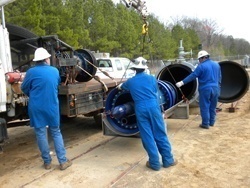Pipeline pigging is a concept in pipeline maintenance that involves the use of devices known as pigs, which clean pipelines and are capable of checking pipeline conditions. This process is done without necessarily interfering with the flow of product in the pipe. Pipeline pigs are used in a number of different industries including oil & gas, lube oil, chemical plants, and hygienic applications such as pharmaceutical or food. Selecting the right pipeline pig for a particular application requires extensive experience, something that Inline provides.
How Does Pipeline Pigging Work?
The primary purpose of pipeline pigs is to make sure that the pipe is clean and free from obstruction. The pig is usually cylindrical or spherical to aid movement and efficient cleaning. As the pig moves through the pipeline, it can remove and possibly detect any build-ups within the pipe which can often lead to reduced performance, increased energy costs, and cause corrosion, which could lead to disastrous leaks and cracks in the pipe.
The Pipeline Pigging Process
The pipeline pig is inserted into the pipe using a pig trap, which is typically oversized to accommodate the tight-fitting pig. A similar pig trap or receiver is located at the end of the pipe to receive the pig once it has traveled the length of the pipeline.
Pigging Uses For Process Media Applications
Media buildup in processing piping can cause transmittal slows or even plugging. Additionally, cracks or flaws in the line can be disastrous, causing leaks that hinder the bottom line and place workers and the environment at risk.
Pigs sweep the line by scraping piping surfaces and pushing debris ahead. They can perform many functions as they travel along a pipeline:
- Clearing The Line
- Breaking Up Clogs
- Inspecting The Interior
- Pipeline Cleaning
How Is The Pig Movement Monitored?
A pig will often make a sound as it travels through a pipe and if it doesn’t, a TX Transmitter can be installed into the pig. The pig can then be tracked through the pipe above ground using an RX101 Receiver or a GeoAmp XT Geophone. Apache pigPro signalers are a reliable indicator that the pig has passed a certain point on the pipeline.
Components Of A Pigging System
Pigging systems are comprised of many pipeline pigging components. Exact parts vary by pigging system, but most applications include pig launchers, receivers, detectors, housings, propellant sources, and storage devices. Additional pigging parts are PLCs, HMIs, control software, supports, valves, and fittings.
All that being said, the actual effectiveness of a pigging system is the pig itself. A pig that’s undersized or made from a specific material may not perform reliably in a specific pipeline. That’s why Inline Services manufactures a wide array of pigging systems and components.
Pigging Products
- Steel Mandrel Pigs
- Poly Foam Pigs
- Pipeline Spheres
- Urethane Pigs
- Custom Pig Configuration
- Speed Control Cleaning Pigs
Pig Parts And Accessories
Equipment And Detection
- Tracking Equipment
- Apache pigPRO Intrusive Passage Indicators
- Non-Intrusive Pig Signallers
- Dewatering Bags
- Dust Bags
- Pig Pole Combo
Product Recovery Systems
- VIPRS® Product Recovery Pigging System For Industrial Applications
- VIPRS® Product Recovery Pigging System For Sanitary Applications
Versatile Flow Optimization Solutions
Inline Services has pigs for virtually every fluid transfer application. Any business that handles liquids can benefit from pigging systems. Examples include:
Industrial Pipeline Pigging Made Easy
With vast experience and a proven track record, Inline Services is your source for high-performance pigging and liquid product recovery solutions. We help you achieve unparalleled productivity, profit, and environmental sustainability gains.
Have More Questions?
We can help! Inline’s team of experts has over 30 years of industry experience and has assisted hundreds of customers globally to identify the best pipeline pigging equipment and plan for their project. Contact us today Toll Free: 888.973.0079 Local: 281.401.8142.


